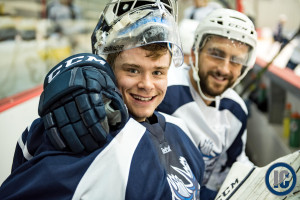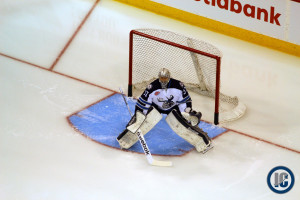Kick start your week with the Monday Manitoba Moose Report, which fills you in on the latest news about the Jets AHL farm club.
This Week’s Manitoba Moose Results
The Moose started out their 4-game road trip with a 3-2 victory over the Milwaukee Admirals. They got goals from Matt Halischuk, Thomas Raffl, and captain John Albert – who got the game-winner near the end of the second period. Unfortunately, after the Milwaukee game, things turned ugly. They lost an 8-2 decision to the Chicago Wolves, and both games against the Toronto Marlies. The first game in Toronto was close – a 3-1 loss which included an empty netter – but the second was painful, a 9-0 thrashing. (Jussi Olkinuora surrended all 9 goals in his first game of the season.) The loss set a record for largest margin of defeat in Manitoba Moose history. While the game was a painful reminder of how far this team has yet to go, it should be noted that the Marlies are an offensive juggernaut, winning 10 games by 4 or more goals, and have scored 9 goals on more than one occasion (the other against St. John’s). In each of the blowout losses, the Moose gave up breakaways and odd-man rushes galore, and also surrendered their first two shorthanded goals of the season – a sure sign that things were coming unglued.
Looking on the bright side, captain John Albert put together a 3-game goal streak over those 4 games (it ended in Sunday’s game against Toronto), and Eric Comrie had two very strong performances, earning second star in the victory over Milwaukee, and also in the 3-1 loss to the Marlies, where he allowed just 2 goals on 35 shots. (Though he was also in net for the 8-2 loss to Chicago).

Year-to-Date
As you might imagine, the team’s numbers on the season aren’t pretty – they have the second worst winning percentage in the AHL, behind only the Iowa Wild (Minnesota’s AHL team), and they’re last in the AHL in goals for, a whole 10 goals back of the next lowest scoring team. In terms of individual contributions, J.C Lipon continues to lead the Moose in most offensive categories, including goals (6), points (13), short-handed goals (2), power-play goals (2 – tied), and penalty minutes (32). Meanwhile, Chase de Leo is having a pretty strong start to his AHL career, with 11 points in 21 games, and a team high 51 shots. It’s a great sign to see him getting so many shots on net, as it shows that he’s able to find space in the offensive zone, either with his legs, or with good positioning. Nic Petan has 4 points in 8 games since being re-assigned from the Jets, while Josh Morrissey has had a tough start to the year, with no goals and 2 assists through 21 games.
This Week’s Schedule
The Moose have a long week of practice ahead of them, as they have the entire week to prepare for home games on Saturday and Sunday against the Milwaukee Admirals (Nashville) . While the Admirals have been a very good team this year (15-6-1-1 record), the Moose have surprised them in back-to-back games, winning each by a 3-2 margin. Hopefully the home club can build on that success before their record, which currently at 5-14-1-1, creates a deficit that’s completely insurmountable.
Spotlight on Connor Hellebuyck
There’s no doubt that Connor Hellebuyck has had a great start to his NHL career. With a record of 3-0-0, and just 3 goals allowed on 86 shots, Hellebuyck has given the Jets the solid, steady goaltending that every team craves. The question everyone has is, at 22 years of age, and with just 68 games played in the AHL, is he ready to be an every-day NHL starter?

There’s certainly no questioning Hellebuyck’s pedigree. As I wrote this summer, the past three years of his career have been stunning – two dominant seasons in the NCAA, including top goaltender awards in 2014, an AHL all-star game appearance in 2015, and a sparkling performance at last spring’s World Championships. If his ascent to the NHL seems sudden, that’s because it is; just 4 years ago, Hellebuyck was a complete unknown, searching for a place to play after finishing high school. He wasn’t even drafted into the USHL or the NAHL – the two main US junior leagues which act as feeders for the US college system. He did manage to get a tryout with the “Jackalopes” in the NAHL, all the way down in Odessa, Texas. And while it seems unusual for a young player from Michigan to travel down to Texas to play hockey, Hellebuyck was happy to go anywhere as long as it meant that he could pursue his hockey career.
Looking at the goalie he’s become, his play is best characterized by the terms big, square, and calm; he’s 6’4, positionally sound, and he rarely gets rattled. He works hard in practice. Off the ice, he’s well-spoken and engaging, and strikes a balance between optimism and realism. If you ask him about a goal he let in, more often than not, he’ll tell you that he thinks he could have stopped it, and will give you a detailed account of what he could have done differently. There’s an analytical mind there.
While there’s no way to know what goaltender Hellebuyck, may become, it’s interesting to compare him to other US goalies, particularly those who took the NCAA route.
There’s the group who took a while to establish themselves as NHL starters, like Ben Bishop, Jimmy Howard, and Ryan Miller, who each played 3 years of college, and several years in the AHL before becoming full-time NHL’ers in their mid-20’s. Of the three, Miller was the most decorated prospect, winning top goaltender in the NCAA all three years, and best AHL goaltender in the lockout season of 2005. Interestingly, while Howard has had the least success of the three, he was drafted the highest – 64th in 2003; Bishop was drafted 85th, and Miller, in the 5th round, 138th overall.
Then there’s Cory Schneider – well known in these parts as a former Moose goaltender, Schneider also played three years of college, and a few years in the AHL, but he was a can’t-miss prospect from the start, drafted in the first round in 2004, and twice a member of US team at the World Junior Championships. Today, Schneider is a very solid starting goaltender for New Jersey, but it took him a while to take the reigns, as he initially settled into a platoon arrangement in Vancouver with Roberto Luongo for three years, followed by another year with Martin Brodeur. He wasn’t an every-day starter till just last season, at age 28.
If you’re looking for stark contrasts, there’s the stories of Al Montoya and Mike Condon. Montoya is well known to Winnipeggers as Ondrej Pavelec’s back-up from 2012-2014, but in a past life, he was a highly touted prospect, who parlayed a fantastic performance at the 2004 World Juniors to being drafted 6th overall. Unfortunately, his career didn’t progress as was expected, and it took him till his mid-20’s to settle into a role as an NHL back-up, a role which he continues to play today. Thus far, Mike Condon is the complete opposite – undrafted and unheralded, he made his way through four seasons of college, and a full season in the ECHL, before a break-out year in the AHL last season gave him an opportunity as the Canadiens back-up this year. Since the injury to Carey Price, he has filled in more than admirably in the starter’s role, and he continues to surprise people with his solid play.
Lastly, there’s Jonathan Quick. While it’s always dangerous to compare a young player to a Conn Smythe winner, there are some definite similarities thus far. Neither played in the USHL, or the US Under-18 team, instead playing with their high school team till graduation. Each of them was passed over once in the draft, and then played two years in the NCAA. And each of them played a full year in the minors, and was called up early in the next season, at the age of 22. (Quick, after 14 games, Hellebuyck, after 10). While their styles are very different – Quick is a smaller, more athletic goalie, with a very intense personality – the timing certainly matches up thus far.
Whose career will Hellebuyck mirror? No one knows. But if Connor Hellebuyck stumbles this season with the Jets, or is sent back to the Moose once Ondrej Pavelec returns to action, take comfort in the stories of Miller, Howard, Bishop, and Schneider, none of whom made their mark in the NHL until their mid-20’s. If you think of prospects within the context of the Tortoise and the Hare, goalies are almost always the tortoise.



